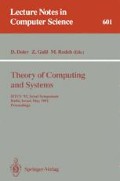Abstract
Temporal events are regarded here as intervals on a time line. This paper deals with problems in reasoning about such intervals when the precise topological relationship between them is unknown or only partially specified. This work unifies notions of interval algebras in artificial intelligence with those of interval orders and interval graphs in combinatorics.
The satisfiability, minimum labeling and all consistent solutions problems are considered for temporal (interval) data. Several versions are investigated by restricting the possible interval relationships yielding different complexity results. We show that even when the temporal data comprises of subsets of relations based on intersection and precedence only, the satisfiability question is NP-Complete. On the positive side, we have obtained efficient algorithms for several restrictions of the problem. In the process, the interval graph sandwich problem is introduced, and is shown to be NP-complete. This problem is also important in molecular biology, where it arises in physical mapping of DNA material.
This article was processed using the LATEX macro package with LLNCS style
Preview
Unable to display preview. Download preview PDF.
References
J. F. Allen. Maintaining knowledge about temporal intervals. Comm. ACM, 26:832–843, 1983.
K. R. Baker, P. C. Fishburn, and F. S. Roberts. Partial orders of dimension 2. Networks, 2:11–28, 1972.
A. Belfer and M. C. Golumbic. Counting endpoint sequences for interval orders and interval graphs. to appear in Discrete Math.
A. Belfer and M. C. Golumbic. The role of combinatorial structures in temporal reasoning. IBM Research Report, (in preparation).
A. Belfer and M. C. Golumbic. A combinatorial approach to temporal reasoning. In Proc. Fifth Jerusalem Conf. on Information Technology, pages 774–780. IEEE Computer Society Press, 1990.
S. Benzer. On the topology of the genetic fine structure. Proc. Nat. Acad. Sci. USA, 45:1607–1620, 1959.
K. S. Booth and G. S. Lueker. Testing for the consecutive ones property, interval graphs, and planarity using PQ-tree algorithms. J. Comput. Sys. Sci., 13:335–379, 1976.
A. Bouchet. Reducing prime graphs and recognizing circle graphs. Combinatorica, 7:243–254, 1987.
C. H. Coombs and J. E. K. Smith. On the detection of structures in attitudes and developmental processes. Psych. Rev., 80:337–351, 1973.
B. Dushnik and E. W. Miller. Partially ordered sets. Amer. J. Math., 63:600–610, 1941.
P. Fishburn. Intransitive indifference with unequal indifference intervals. J. Math. Psych., 7:144–149, 1970.
P. Fishburn. Interval Orders and Interval Graphs. Wiley, New York, 1985.
D. R. Fulkerson and O. A. Gross. Incidence matrices and interval graphs. Pacific J. Math., 15:835–855, 1965.
C. P. Gabor, K. J. Supowit, and W-L Hsu. Recognizing circle graphs in polynomial time. J. ACM, 36:435–473, 1989.
P. C. Gilmore and A. J. Hoffman. A characterization of comparability graphs and of interval graphs. Canad. J. Math., 16:539–548, 1964.
M. C. Golumbic. Algorithmic Graph Theory and Perfect Graphs. Academic Press, New York, 1980.
M. C. Golumbic. Interval graphs and related topics. Discrete Math., 55:113–121, 1985.
M. C. Golumbic and E. R. Scheinerman. Containment graphs, posets and related classes of graphs. Ann. N.Y. Acad. Sci., 555:192–204, 1989.
M. C. Golumbic and R. Shamir. Complexity and algorithms for reasoning about time: A graph-theoretic approach. Technical Report 91-54, DIMACS Center, Rutgers University, NJ, 1991. Submitted.
D. G. Kendall. Incidence matrices, interval graphs, and seriation in archaeology. Pacific J. Math., 28:565–570, 1969.
D. G. Kendall. Some problems and methods in statistical archaeology. World Archaeol., 1:68–76, 1969.
N. Korte and R. H. Möhring. An incremental linear time algorithm for recognizing interval graphs. SIAM J. Comput., 18:68–81, 1989.
P. B. Ladkin and R. Maddux. The algebra of constraint satisfaction problems and temporal reasoning. Technical report, Kestrel Institute, Palo Alto, 1988.
P. B. Ladkin and R. Maddux. On binary constraint networks. Technical report, Kestrel Institute, Palo Alto, 1988.
C. G. Lekkerkerker and J. Ch. Boland. Representation of a finite graph by a set of interval on the real line. Fundam. Math., 51:45–64, 1962.
K. Nökel. Convex relations between time intervals. Technical Report SR-88-17, Univ. Kaiserslautern, 1988.
C. Papadimitriou and M. Yannakakis. Scheduling interval ordered tasks. SIAM J. Comput., 8:405–409, 1979.
F. S. Roberts. Discrete Mathematical Models, with Applications to Social Biological and Environmental Problems. Prentice-Hall, Englewood Cliffs, New Jersey, 1976.
T. J. Schaefer. The complexity of satisfiability problems. In Proc. 10th Annual ACM Symp. on Theory of Computing, pages 216–226, 1978.
A. Tarski. On the calculus of relations. Journal of Symbolic Logic, 6:73–89, 1941.
P. vanBeek. Approximation algorithms for temporal reasoning. In Proc. Eleventh Int'l. Joint Conf. on Artificial Intelligence (IJCAI-89), pages 1291–1296, August 1989.
P. van Beek. Reasoning about qualitative temporal information. In Proc. Eighth Nat'l. Conf. on Artificial Intelligence (AAAI-90), pages 728–734, August 1990.
M. Vilian and H. Kautz. Constraint propagation algorithms for temporal reasoning. In Proc. Fifth Nat'l. Conf. on Artificial Intelligence (AAAI-86), pages 337–382, August 1986.
Author information
Authors and Affiliations
Editor information
Rights and permissions
Copyright information
© 1992 Springer-Verlag Berlin Heidelberg
About this paper
Cite this paper
Golumbic, M.C., Shamir, R. (1992). Interval graphs, interval orders and the consistency of temporal events (extended abstract). In: Dolev, D., Galil, Z., Rodeh, M. (eds) Theory of Computing and Systems. ISTCS 1992. Lecture Notes in Computer Science, vol 601. Springer, Berlin, Heidelberg. https://doi.org/10.1007/BFb0035164
Download citation
DOI: https://doi.org/10.1007/BFb0035164
Published:
Publisher Name: Springer, Berlin, Heidelberg
Print ISBN: 978-3-540-55553-7
Online ISBN: 978-3-540-47214-8
eBook Packages: Springer Book Archive

